I should remind myself not to listen to the media (even the public broadcaster) when…
Australian labour market – continues to languish
The latest labour force data released today by the Australian Bureau of Statistics – Labour Force data – for April 2016 show that those ominous signs that have been apparent for most of this year are still hovering above the labour market. Total employment growth was virtually non-existent with only 10,800 (net) jobs created. Full-time employment decreased 9,300, while part-time employment increased by 20,200. It is the second consecutive month of negative full-time employment growth, which highlights the deteriorating labour market situation in Australia. There was also a decline in hours worked which is now trending downwards. Over the last six months, around 87 per cent of the net jobs created have been part-time. The growth in part-time work suggests that overall the quality of work in Australia again deteriorated. So overall a poor outcome. Unemployment rose marginally this month but this is largely because the weak employment growth is interacting with even weaker labour force growth. The participation rate fell again. The teenage labour market remains in a poor state and requires urgent policy intervention. Overall, with weak private investment now on-going, the Australian labour market is looking very weak and the Federal government should have introduced a rather sizeable fiscal stimulus in its recent fiscal statement. This should have included a large-scale public sector job creation program which would ensure teenagers regained the jobs that have been lost due to the fiscal drag over the last several years. However, the Federal government appears incapable of addressing this dire issue. It is embroiled in mythical discussions about running out of money and not being able to defend the economy if there is another crisis. All make believe, while the real world does head towards another major rift. It is up to the Opposition to shift the political agenda (in the current election campaign). But, they are missing in action on these important issues.
The summary ABS Labour Force (seasonally adjusted) estimates for April 2016 are:
- Employment increased 10,800 (0.2 per cent) with full-time employment decreasing by 9,300 (the second consecutive month of negative full-time employment growth) and part-time employment increasing by 20,200.
- Unemployment increased by 400 to 723,300.
- The official unemployment rate remained steady at 5.7 per cent.
- The participation rate decreased by less than 0.1 percentage points to 64.8 per cent. This is well below its November 2010 peak (recent) of 65.8 per cent.
- Aggregate monthly hours worked decreased 17.9 million hours (-1.1 per cent), the second consecutive month of negative growth.
- The quarterly ABS broad labour underutilisation estimates (the sum of unemployment and underemployment) for the February quarter were updated last month. Underemployment was at 8.4 per cent and total labour underutilisation rate was at 14.2 per cent. There were 1,051.2 thousand persons underemployed and a total of 1.839.3 thousand workers either unemployed or underemployed. The next quarterly release will be in the June 2016 publication.
Yesterday (May 18, 2016), the Australian Bureau of Statistics published the latest – Wage Price Index – data for April 2016 which showed the slowest quarterly wages growth since the time series began in the September-quarter 1998.
Translated into real wages, it is clear that productivity growth, though low, is still running well ahead of the growth in real wages growth (which is close to zero or slightly negative) over the last year or more.
If the mainstream economics textbooks were correct, then employment in Australia should be booming given the massive suppression of wages that has been on-going for several years now.
But you know the story as well as I do.
The mainstream story is false. The slack employment growth that persists in Australia is due to the weak overall real GDP growth that is suppressing sales growth and giving employers no reason to expand job numbers much.
The two data sets – yesterday’s wage data and today’s labour force data – taken together, reveal that the Australian labour market continues to languish.
Employment growth – non-existent with full-time employment continuing to go backwards
Total (net) employment in April 2016 is estimated to have increased by 10,800 jobs. Full-time employment decreased 9,300, while part-time employment increased by 20,200.
It is the second consecutive month of negative full-time employment growth, which highlights the deteriorating labour market situation in Australia.
The ABS said that:
Trend employment growth in Australia continued to ease … Over the past month, trend employment increased by 4,100 persons to 11,910,800 persons – a monthly growth rate of 0.03 per cent. This monthly growth rate was below the monthly average over the past 20 years (0.15 per cent), and down further from the recent peak of 0.26 per cent in October 2015.
So things are deteriorating.
The zig-zag pattern that we have observed over the last 36 months or so – where the employment estimates have been switching back and forth regularly between negative employment growth and positive growth with the occasional spikes – continues.
The following graph shows the month by month growth in full-time (blue columns), part-time (grey columns) and total employment (green line) for the 24 months to April 2016 using seasonally adjusted data.
It gives you a good impression of just how flat employment growth has been over the last 2 years.
The following table provides an accounting summary of the labour market performance over the last six months. The monthly data is highly variable so this Table provides a longer view which allows for a better assessment of the trends. WAP is working age population (above 15 year olds).
The conclusion – overall there have only been 100.7 thousand jobs (net) added in Australia over the last six months while the labour force has increased by only 84.1 thousand. Employment growth has thus outstripped the increase in the supply of labour with the result that unemployment has fallen by 16.6 thousand.
This should not be taken as an indication of strong employment growth. Rather, the weak participation has meant the labour force growth rate has slowed significantly.
Full-time employment has risen by only 13.4 thousand jobs (net) while part-time work has risen by 87.3 thousand jobs. Thus, 86.7 per cent of the total employment created (net) over the last 6 months has been part-time.
The participation rate has fallen by 0.1 points and remains at depressed levels.
The following graph shows employment indexes for the last 3 recessions and allows us to see how the trajectory of total employment after each peak prior to the three major recessions in recent history: 1982, 1991 and 2009 (the latter to capture the current episode).
The peak is defined as the month of the low-point unemployment rate in the relevant cycle and total employment was indexed at 100 in each case and then indexed to that base for each of the months as the recession unfolded.
I have plotted the 3 episodes for 98 months after the low-point unemployment rate was reached in each cycle – the length of the current cycle.
The initial employment decline was similar for the 1982 and 1991 recessions but the 1991 recovery was delayed by many months and the return to growth much slower than the 1982 recession.
The current episode is distinguished by the lack of a major slump in total employment, which reflects the success of the large fiscal stimulus in 2008 and 2009.
However, the recovery spawned by the stimulus clearly dissipated once the fiscal position was reversed and the economy fell back into producing very subdued employment outcomes.
While the employment growth was stronger in October and November 2015 we now know that the estimates were distorted by the rotational issues in the sample used by the ABS as well as other issues relating to survey reliability over that period.
Moreover, since February 2008, employment has grown by a miserly 12 per cent, which is a very slow pace in historical terms for such a long period.
Given the variation in the labour force estimates, it is sometimes useful to examine the Employment-to-Population ratio (%) because the underlying population estimates (denominator) are less cyclical and subject to variation than the labour force estimates. This is an alternative measure of the robustness of activity to the unemployment rate, which is sensitive to those labour force swings.
The following graph shows the Employment-to-Population ratio, since February 2008 (the low-point unemployment rate of the last cycle).
It dived with the onset of the GFC, recovered under the boost provided by the fiscal stimulus packages but then went backwards again as the last Federal government imposed fiscal austerity in a hare-brained attempt at achieving a fiscal surplus.
The ratio began rising in October 2014 which suggested to some that the labour market had bottomed out and would improve slowly as long as there are no major policy contractions or cuts in private capital formation.
However, the peak in November is now gone (partly distorted by the sample survey issues) and the ratio is once again in retreat.
The on-going fiscal deficit is still supporting growth in the economy as the spending associated with the mining boom disappears.
The series remained unchanged in April 2016 but remains 1.8 points below the April 2008 peak of 62.9 per cent.
Teenage labour market – slides backward this month
The teenage labour market went backwards again in April 2016 with full-time employment rising by 2.7 thousand but part-time employment falling by 9.6 thousand (net) jobs.
Total employment thus fell by 6.9 thousand (net).
The following graph shows the distribution of net employment creation in the last month by full-time/part-time status and age/gender category (15-19 year olds and the rest)
If you take a longer view you see how poor the situation remains.
Over the last 12 months, teenagers have gained only 11 thousand (net) jobs overall while the rest of the labour force have gained 233.7 thousand net jobs. Remember that the overall result represents a fairly poor annual growth in employment.
The teenage segment of the labour market is being particularly dragged down by the sluggish employment growth, which is hardly surprising given that the least experienced and/or most disadvantaged (those with disabilities etc) are rationed to the back of the queue by the employers.
The following graph shows the change in aggregates over the last 12 months. It is as if the teenagers have not had a stake in the labour market either way (blue bars barely visible).
To further emphasise the plight of our teenagers, I compiled the following graph that extends the time period from the February 2008, which was the month when the unemployment rate was at its low point in the last cycle, to the present month (April 2016). So it includes the period of downturn and then the so-called “recovery” period. Note the change in vertical scale compared to the previous two graphs.
Since February 2008, there have been only 1,269.6 thousand (net) jobs added to the Australian economy but teenagers have lost a staggering 100.4 thousand over the same period. It is even more stark when you consider that 107.3 thousand full-time teenager jobs have been lost in net terms.
Even in the traditionally, concentrated teenage segment – part-time employment, teenagers have gained only 6.9 thousand jobs (net) even though 745.1 thousand part-time jobs have been added overall.
Overall, the total employment increase is modest. Further, around 59 per cent of the total (net) jobs added since February 2008 have been part-time, which raises questions about the quality of work that is being generated overall.
To put the teenage employment situation in a scale context the following graph shows the Employment-Population ratios for males, females and total 15-19 year olds since February 2008 (the month which coincided with the low-point unemployment rate of the last cycle).
You can interpret this graph as depicting the loss of employment relative to the underlying population of each cohort. We would expect (at least) that this ratio should be constant if not rising somewhat (depending on school participation rates).
The facts are that the absolute loss of jobs reported above is depicting a disastrous situation for our teenagers. Males, in particular, have lost out severely as a result of the economy being deliberately stifled by austerity policy positions.
In the last month, with the employment situation improving, there has been some reversal in the downward trends in these ratios.
The male ratio has fallen by 11.4 percentage points since February 2008, the female ratio has fallen by 5.1 percentage points and the overall teenage employment-population ratio has fallen by 8.3 percentage points. That is a substantial decline in the employment market for Australian teenagers.
The other staggering statistic relating to the teenage labour market is the decline in the participation rate since the beginning of 2008 when it peaked in January at 61.4 per cent. In April 2016, the participation rate was just 53.3 per cent.
That is an additional 116.9 thousand teenagers who have dropped out of the labour force as a result of the weak conditions since the crisis.
If we added them back into the labour force the teenage unemployment rate would be 28.4 per cent rather than the official estimate for April 2016 of 17.5 per cent. Some may have decided to return to full-time education and abandoned their plans to work. But the data suggests the official unemployment rate is significantly understating the actual situation that teenagers face in the Australian labour market.
Overall, the performance of the teenage labour market remains poor. It doesn’t rate much priority in the policy debate, which is surprising given that this is our future workforce in an ageing population. Future productivity growth will determine whether the ageing population enjoys a higher standard of living than now or goes backwards.
I continue to recommend that the Australian government immediately announce a major public sector job creation program aimed at employing all the unemployed 15-19 year olds, who are not in full-time education or a credible apprenticeship program.
Unemployment increased by 400 to 723,300
TThe official unemployment rate remained steady at 5.7 per cent in April 2016, but would have risen had not the participation rate fallen.
Overall, the labour market still has significant excess capacity available in most areas and what growth there is is not making any major inroads into the idle pools of labour.
The following graph shows the national unemployment rate from February 1978 to April 2016. The longer time-series helps frame some perspective to what is happening at present.
After falling steadily as the fiscal stimulus pushed growth along, the unemployment rate slowly trended up for some months.
It is now above the peak that was reached just before the introduction of the fiscal stimulus. In other words, the gains that emerged in the recovery as a result of the fiscal stimulus in 2009-10 have now been lost.
Broad labour underutilisation – upwards of 14.2 per cent
The ABS published its quarterly broad labour underutilisation measures for the February-quarter in this month’s data release.
In the February-quarter, total underemployment was 8.4 per cent and the ABS broad labour underutilisation rate (the sum of unemployment and underemployment) was 14.2 per cent.
There were 1,058.9 thousand persons underemployed and a total of 1,791.5 thousand workers either unemployed or underemployed.
The following graph plots the history of underemployment in Australia since February 1978 to the February-quarter 2015.
If hidden unemployment is added to the broad ABS figure the best-case (conservative) scenario would see a underutilisation rate well above 16 per cent at present. Please read my blog – Australian labour underutilisation rate is at least 13.4 per cent – for more discussion on this point.
The next update will be for the May-quarter 2016 and will be published published in the June 2016 Labour Force release.
Aggregate participation rate – fell to 64.8 per cent and remains at depressed levels
The April 2016 participation rate decreased by less than 0.1 pts to 64.8 per cent. It remains substantially down on the most recent peak in November 2010 of 65.8 per cent when the labour market was still recovering courtesy of the fiscal stimulus.
Unemployment rose by 400 this month but this would have been higher had the participation rate not eased a bit.
The labour force is a subset of the working-age population (those above 15 years old). The proportion of the working-age population that constitutes the labour force is called the labour force participation rate. Thus changes in the labour force can impact on the official unemployment rate, and, as a result, movements in the latter need to be interpreted carefully. A rising unemployment rate may not indicate a recessing economy.
The labour force can expand as a result of general population growth and/or increases in the labour force participation rates.
What would have the unemployment rate been had the participation rate not fallen by (less than) 0.1 points?
The following Table shows the breakdown in the changes to the main aggregates (Labour Force, Employment and Unemployment) and the impact of the rise in the participation rate.
In April 2016, the rise in employment of 10,800 (net) jobs was accompanied by a labour force increase of only 11,200 thousand. As a result, unemployment increased by 0.4 thousand.
The rising labour force in April 2016 was the outcome of two separate factors:
- The underlying population growth added 14.1 thousand persons to the labour force. The population growth impact on the labour force aggregate is relatively steady from month to month but has slowed in recent months; and
- The fall in the participation rate meant that there were 2.8 thousand workers dropping out of the labour force (relative to what would have occurred had the participation rate remained unchanged).
- The net result was the rise in the labour force of 11.2 thousand (rounded).
If the participation rate had not have fallen, total unemployment, at the current employment level, would have been 726.1 thousand rather than the official count of 723.3 thousand as recorded by the ABS – a difference of 2.8 thousand workers (the ‘participation effect’).
Thus, without the fall in the participation rate, the unemployment rate would have been 5.74 per cent (rounded) rather than its current value of 5.72 per cent.
The conclusion is that hidden unemployment rose slightly in April 2016 while official unemployment rate remained unchanged.
There is considerable monthly fluctuation in the participation rate but the current rate of 64.8 per cent is a long way below its most recent peak in November 2010 of 65.8 per cent.
What would the unemployment rate be if the participation rate was at the last November 2010 peak level value?
The following graph tells us what would have happened if the participation rate had been constant over the period November 2010 to April 2016. The blue line is the official unemployment rate since its most recent low-point of 4 per cent in February 2008.
The red line starts at November 2010 (the peak participation month). It is computed by adding the workers that left the labour force as employment growth faltered (and the participation rate fell) back into the labour force and assuming they would have been unemployed. At present, this cohort is likely to comprise a component of the hidden unemployed (or discouraged workers).
Total official unemployment in April 2016 was estimated to be 723.3 thousand. However, if participation had not have fallen relative to November 2010, there would be 908.4 thousand workers unemployed given growth in population and employment since November 2010.
The unemployment rate would now be 7.1 per cent if the participation had not fallen below its November 2010 peak of 65.8 per cent. The official unemployment in April 2016 was 5.7 per cent.
The difference between the two numbers mostly reflects, the change in hidden unemployment (discouraged workers) since November 2010. These workers would take a job immediately if offered one but have given up looking because there are not enough jobs and as a consequence the ABS classifies them as being Not in the Labour Force.
There has been some change in the age composition of the labour force (older workers with low participation rates becoming a higher proportion) but this only accounts for about a 1/3 of the shift. The rest is undoubtedly accounted for by the rise in hidden unemployment.
Note, the gap between the blue and red lines doesn’t sum to total hidden unemployment unless November 2010 was a full employment peak, which it clearly was not. The interpretation of the gap is that it shows the extra hidden unemployed since that time.
This gap shrinks as participation rises relative to the November 2010 peak.
Hours worked – fell again in April 2016
Aggregate monthly hours fell by 17.9 million hours (-1.1 per cent) in April 2016 in seasonally adjusted terms. This is the third consecutive month that total working hours have contracted.
The following graph shows the monthly growth (in per cent) over the last 24 months. The dark linear line is a simple regression trend of the monthly change – which depicts a decreasing trend.
The labour market has weakened over the last two years.
You can see the pattern of the change in working hours is also portrayed in the employment graph – zig-zagging across the zero growth line.
Conclusion
I always repeat my monthly warning – we always have to be careful interpreting month to month movements given the way the Labour Force Survey is constructed and implemented.
Today’s figures show that while employment growth was just positive this month the pattern of growth continues to zig-zag across the zero growth line.
While 10,800 (net) jobs were created in Australia in April 2016 – full-time employment declined sharply as did hours worked. Both have declined in consecutive months now.
Further, the growth in part-time work suggests that overall the quality of work in Australia declined in April 2016.
The conclusion remains that the overall demand side of the labour market is very weak.
Unemployment rose slightly this month but this is largely because the weak employment growth is interacting with weak labour force growth. If labour force growth was consistent with past trends, then the jobs shortfall would be much larger.
Unemployment was also aided this month by a slight decline in the participation rate (2.8 thousand impact).
The teenage labour market remains in a poor state even though the 15-19 year olds enjoyed part-time employment growth.
I consider this situation to warrant immediate attention by the Federal Government. The neglect of our teenagers will have a very long memory indeed and the negative consequences will be stronger given the ageing population.
The Federal government appears incapable of addressing this dire issue. They are embroiled in mythical discussions about running out of money and not being able to defend the economy if there is another crisis.
All make believe, while the real world does head towards another major rift.
That is enough for today!
(c) Copyright 2016 William Mitchell. All Rights Reserved.
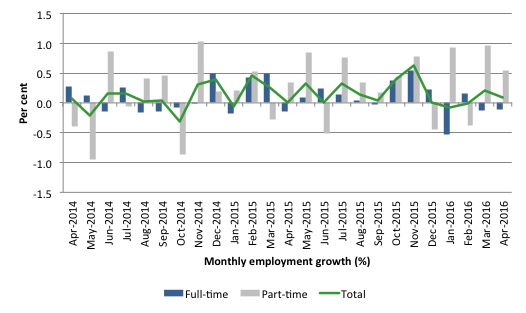
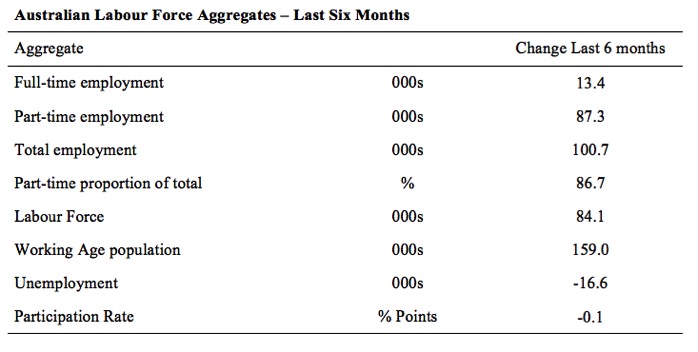
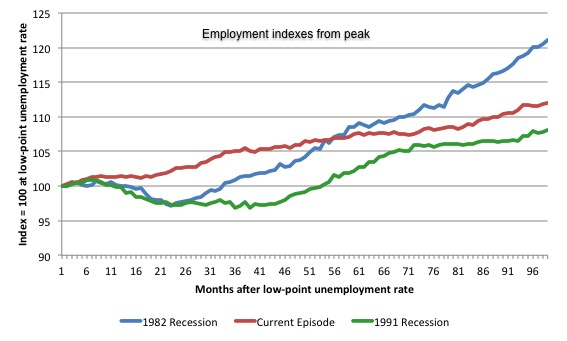
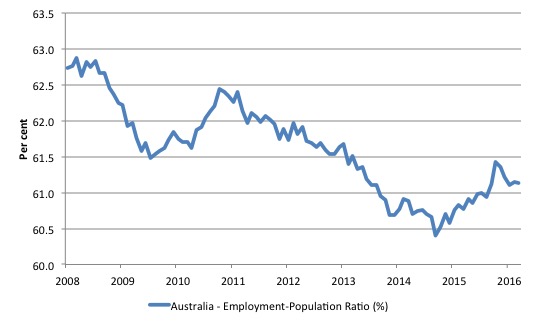
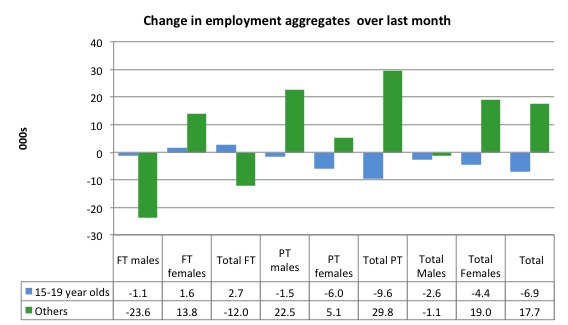
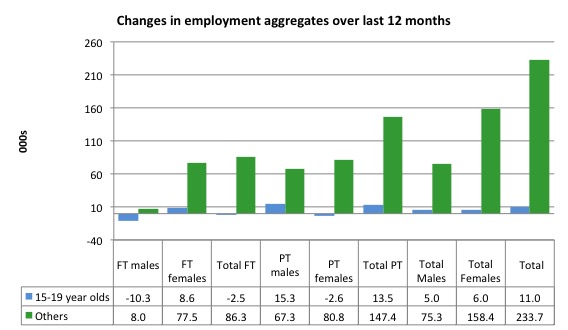
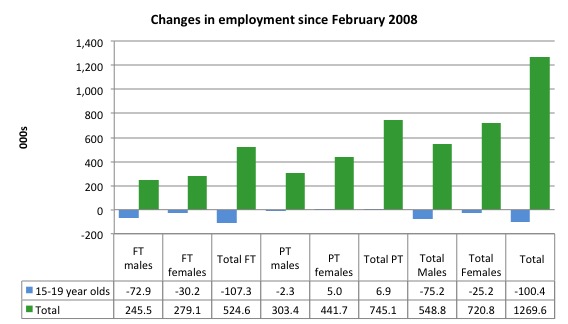
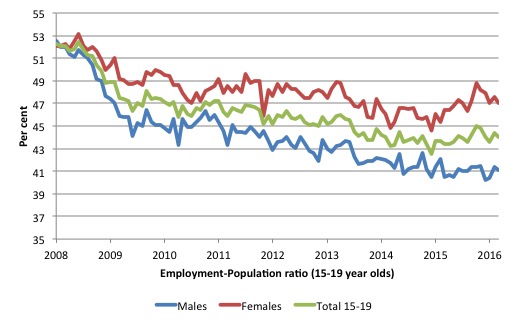

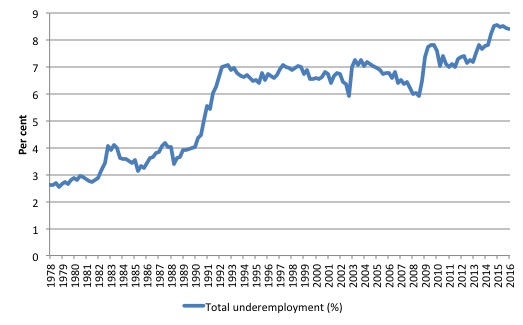
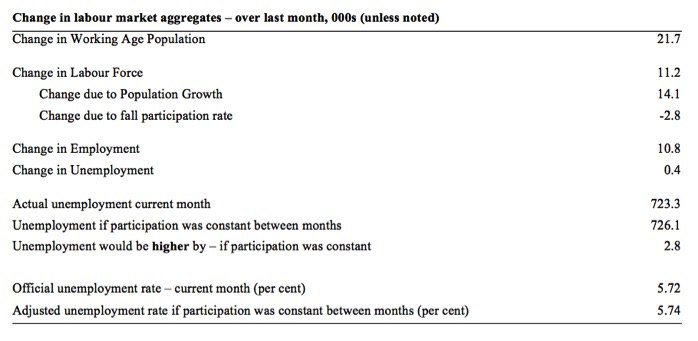
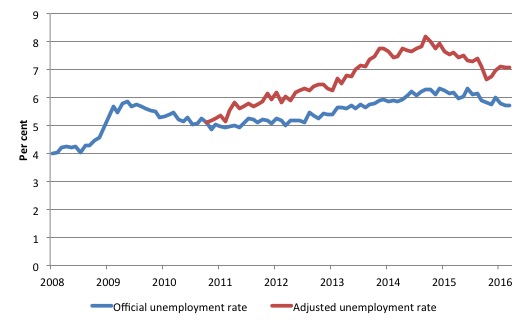
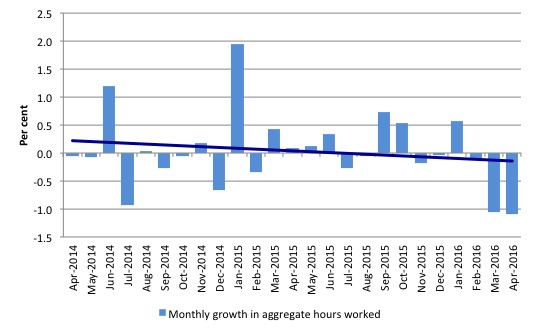
What an indictment on the federal government! You’d think the issue would be a major one during a federal election but apart from the LNP-IPA mantra that they will bring about “jobs and growth” they have done nothing to support the economy fiscally and in fact are set to impose further spending cuts when (as expected) they will be re-elected.
Interest rate policy seems to be the only response and even the neo-liberal Reserve Bank governors has at various times advocated for greater use of fiscal measures but we get from Motormouth Morrison is “we have to live within our means” and similar ignorant or socio-pathic pronouncements.
When motor vehicle building ceases in 2017 some 40,000 could be added to the number of jobless. One suspects the current regime (does not deserve the more respectable title of “government”) actually welcomes further deterioration as one of their agendas appears to be driving down wages and conditions.
I think they do welcome it, Barri. I think it’s deliberate. I’m SURE it’s deliberate.
And trying to reverse it is so hard because ordinary, decent people want a basically equitable society and can’t comprehend their so called government chose inequality 30 years ago. I’ve had this conversation with so many people – all ages, all political leanings – and that’s always the sticking point. That’s always where the conversation ends.
The young are so dispirited, so beaten, most of them don’t even enrol to vote. They can’t see the point in choosing between Neoliberal Thing One and Neoliberal Thing Two.
And I totally get that: I stopped enrolling for decades for the same reason until Abbott was voted in and I’d finally had enough and felt ashamed of myself for letting it happen.
I was born in ’65 and I’ve heard nothing but Neoliberalist bull shit from the mainstream media and politcians all my adult life. But at least I can dimly remember a different paradigm in my childhood. The young have only ever heard the Neoliberal version of reality.
I am trying to spread the word Kathy as Bill urges us to do. Labor is marginally better and the Greens seem to be weak on economic issues. I agree with their stance on the environment but they are “neo-liberals on bikes” as Bill says, on economics.
The neo-liberal paradigm is accepted almost without question and it is very hard to convince friends and online that it is not only incorrect but enormously damaging to well-being everywhere. Except for a very few they shake their heads and say “that can’t be right” as we all know the federal government funds itself from our taxes and deficits are ultimately not sustainable.
But I will keep plugging away and regularly think about ways of expressing the essential concepts of MMT in terms that people may be able to relate to. It was a “lightbulb” moment for me when I finally comprehended it and now can no longer see the world in the same way.